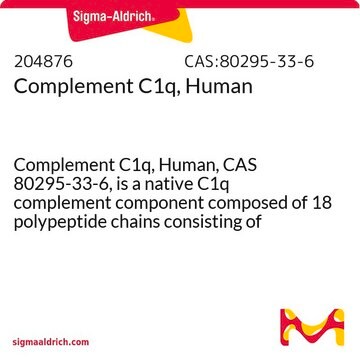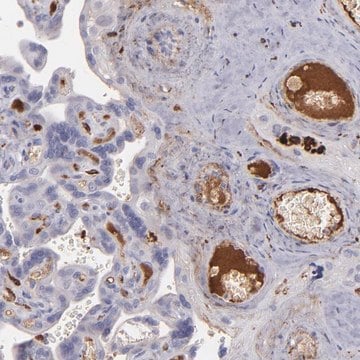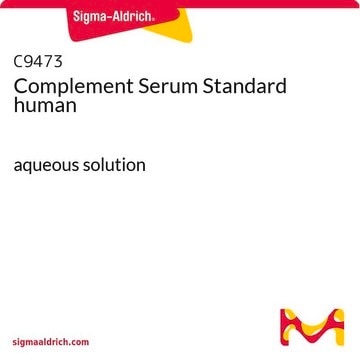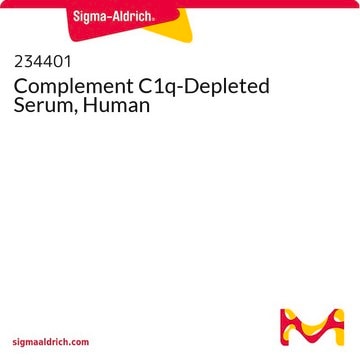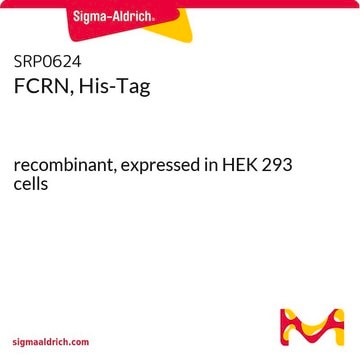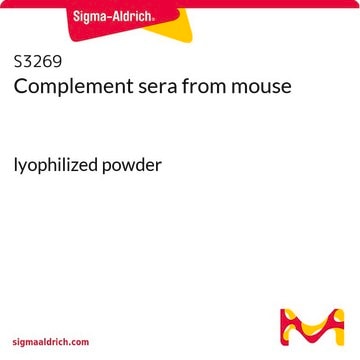This product corresponds to purified 'native' human C1q. Its sequence is not determined in-house. Please refer to published sequences, e.g. in GenBank for UniProt accession nos. P02745, P02746, & P02747.
C1740
Complement component C1q from human serum
≥95% (SDS-PAGE)
Sinonimo/i:
C1q from human serum
Scegli un formato
Scegli un formato
About This Item
Prodotti consigliati
Origine biologica
human
Livello qualitativo
Saggio
≥95% (SDS-PAGE)
Stato
liquid
tecniche
activity assay: suitable
Condizioni di spedizione
dry ice
Temperatura di conservazione
−70°C
Cerchi prodotti simili? Visita Guida al confronto tra prodotti
Descrizione generale
Applicazioni
Azioni biochim/fisiol
Stato fisico
Codice della classe di stoccaggio
10 - Combustible liquids
Classe di pericolosità dell'acqua (WGK)
WGK 3
Punto d’infiammabilità (°F)
Not applicable
Punto d’infiammabilità (°C)
Not applicable
Scegli una delle versioni più recenti:
Certificati d'analisi (COA)
Non trovi la versione di tuo interesse?
Se hai bisogno di una versione specifica, puoi cercare il certificato tramite il numero di lotto.
Possiedi già questo prodotto?
I documenti relativi ai prodotti acquistati recentemente sono disponibili nell’Archivio dei documenti.
I clienti hanno visto anche
-
I ordered the C1740-1MG with lot#0000356664. I would like to know the protein sequences and the extinction coefficient about this protein?
1 answer-
Helpful?
-
-
what is the size of the protein in WB ? when I test it's size it was approximately 24 KD ( the same size as c1q-c )
1 answer-
C1q is composed of 18 polypeptide chains (six A, six B, six C). When prepared in denaturing sample buffer, and run on SDS PAGE, the chains will likely dissociate and run at their individual molecular weights. The Uniprot entries for C1qA, C1qB, and C1qC list masses of 26,017, 26,722, and 25,774, respectively.
Helpful?
-
-
Is this product suitable for use in cell cultures?
1 answer-
This product has not been tested for suitability in cell culture. The end user will need to determine suitability. However, there are multiple publications citing the use of this product in cell culture applications. Please see the link below to review an example:
https://www.ncbi.nlm.nih.gov/pmc/articles/PMC4377823/Helpful?
-
-
Hola, me gustaría saber como se reconstituye el producto para su uso en ensayos. Gracias.
1 answer-
This product is not suitable for use in clinical trials. Unless otherwise stated, this product is intended for research use only. It is not suitable for any other purpose, which includes, but is not limited to, unauthorized commercial use, in vitro diagnostic use, or therapeutic use in humans or animals.
Helpful?
-
-
What is the concentration of C1740?
1 answer-
The product is supplied at a concentration of approximately 1 mg/ml. The exact concentration is lot specific and reported on the Certificate of Analysis.
Helpful?
-
Active Filters
Il team dei nostri ricercatori vanta grande esperienza in tutte le aree della ricerca quali Life Science, scienza dei materiali, sintesi chimica, cromatografia, discipline analitiche, ecc..
Contatta l'Assistenza Tecnica.